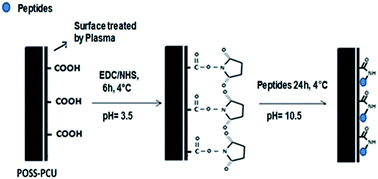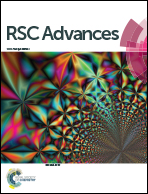Peptide functionalisation of nanocomposite polymer for bone tissue engineering using plasma surface polymerisation
Abstract
In this work, we explored the modification of a new nanocomposite polymer called POSS-PCU for its functionalisation with bone inducing peptides using a plasma surface polymerisation method for bone tissue engineering applications. KRSR and FHRRIKA peptides, which are heparin binding domains, have been shown before to induce cell adhesion and bone mineralisation. In this work a plasma surface polymerisation process was developed to graft biomimetic peptides on polymeric biomaterial. Plasma polymerisation and peptide coupling was confirmed using various techniques such as toluidine blue O assay, IR-spectroscopy and X-ray photon spectroscopy (XPS). Surface chemical analysis confirmed that 10 W power and 20 min of plasma treatment was optimum in order to obtain the highest grafting density of carboxyl groups, which were later used to attach bone biomimetic peptides via carbodiimide chemistry. IR-spectroscopy and XPS confirmed functionalisation with carboxyl and peptide grafting. Finally, preliminarily in vitro study with bone marrow mesenchymal stem cells was performed in order to assess the efficacy of peptide functionalised surfaces to promote differentiation into osteogenic lineage. Cell tests showed increased cell adhesion and osteoblastic differentiation on KRSR and FHRRIKA peptide modified samples. This study has implications for the design and development of a new generation of orthopedic implants using the plasma modification technique.


 Please wait while we load your content...
Please wait while we load your content...